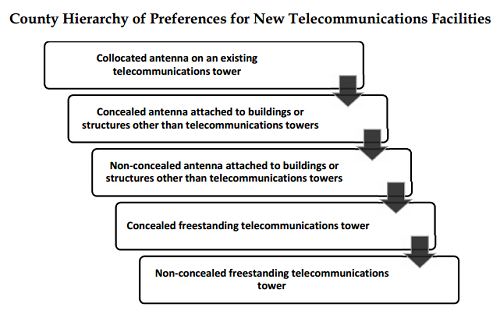Piedmont Environmental Council has concern about some of the changes being proposed in Fauquier County’s rewrite of the Plan for Commercial Wireless Facilities. This section of the County Comprehensive plan sets the policies and goals regarding how telecommunications facilities should be integrated into the landscape. Our two major concerns are about the vague language proposed and the fact that a new telecommunication zoning ordinance is being proposed at the same time.
Comprehensive Plan and Zoning Amendments Proposed in Conjunction

The Plan for Commercial Wireless Facilities is a section of the Comprehensive Plan and is meant to establish the policies and goals of the locality in regards to telecommunication while the zoning ordinance is supposed to implement those goals and follow the policies established in the most efficient and expeditious manner possible. Conducting work sessions on both at the same time muddies the policies and goals of the comprehensive plan with specific zoning criteria and objectives of expediting the process for applicants. More importantly conducting these changes in conjunction takes away from the time citizens have to review the new policies and zoning changes and give their representatives feedback.
Vague Language
The draft plan includes a clear hierarchy establishing what is desirable and what is not in terms of design of telecommunication towers which is a good addition. However, more information is needed to help guide not just design of these towers but also appropriate siting. The draft language states that the zoning should:
“Prohibit non-concealed facilities that impact the County’s most significant scenic vistas and cultural and environmental resources, and carefully review and control even concealed facilities within view of these areas.”
There is sometimes a fine line between what needs to be in the comprehensive plan and what should go into the zoning ordinance, but this seems too vague to provide much direction in drafting the zoning. Important resources should be clearly identified in this chapter; such as scenic byways, scenic rivers, historic districts, rural historic districts, battlefields, mountain tops, scenic overlooks, federal and state parks, etc. There is also an opportunity to strengthen this section of the Comprehensive Plan by cross referencing other sections of the Comprehensive Plan and emphasizing that these resources are consistently recognized as contributing to the quality of life and the tourism economy in the County.
Reference to Regulatory Framework
PEC also has concerns about the inclusion of the regulatory framework. The fact that any zoning the County adopts will be consistent with federal and state law is assumed and thus is an unnecessary section to the Commercial Wireless Telecommunication Facilities that will need to be updated every time the regulations change. The Federal Communications Commission 2013 Guidance, in particular, should not be included as this is pending in rule making proceedings and will most likely be clarified and possible amended by the end of 2014.
Non-concealed Freestanding Telecommunication Towers
Section E on “Non-Concealed Freestanding Telecommunication Towers”, does not establish a clear policy or reasoning for that policy. It states,
“This alternative should be allowed only with careful consideration by the Board of Supervisors and only as a last-resort, with the applicant bearing the burden of proof that more desirable approaches are impossible.”
The negative impact these towers can have on adjacent landowners, scenic resources, historic resources, and tourism should be clearly described in this section.
The phrase “only as a last-resort” used in this section is not clear and would be difficult to defend. This should be clarified to say that all other options for siting and concealment have been exhausted.
These comments were sent to the County as of 7/14/14.
